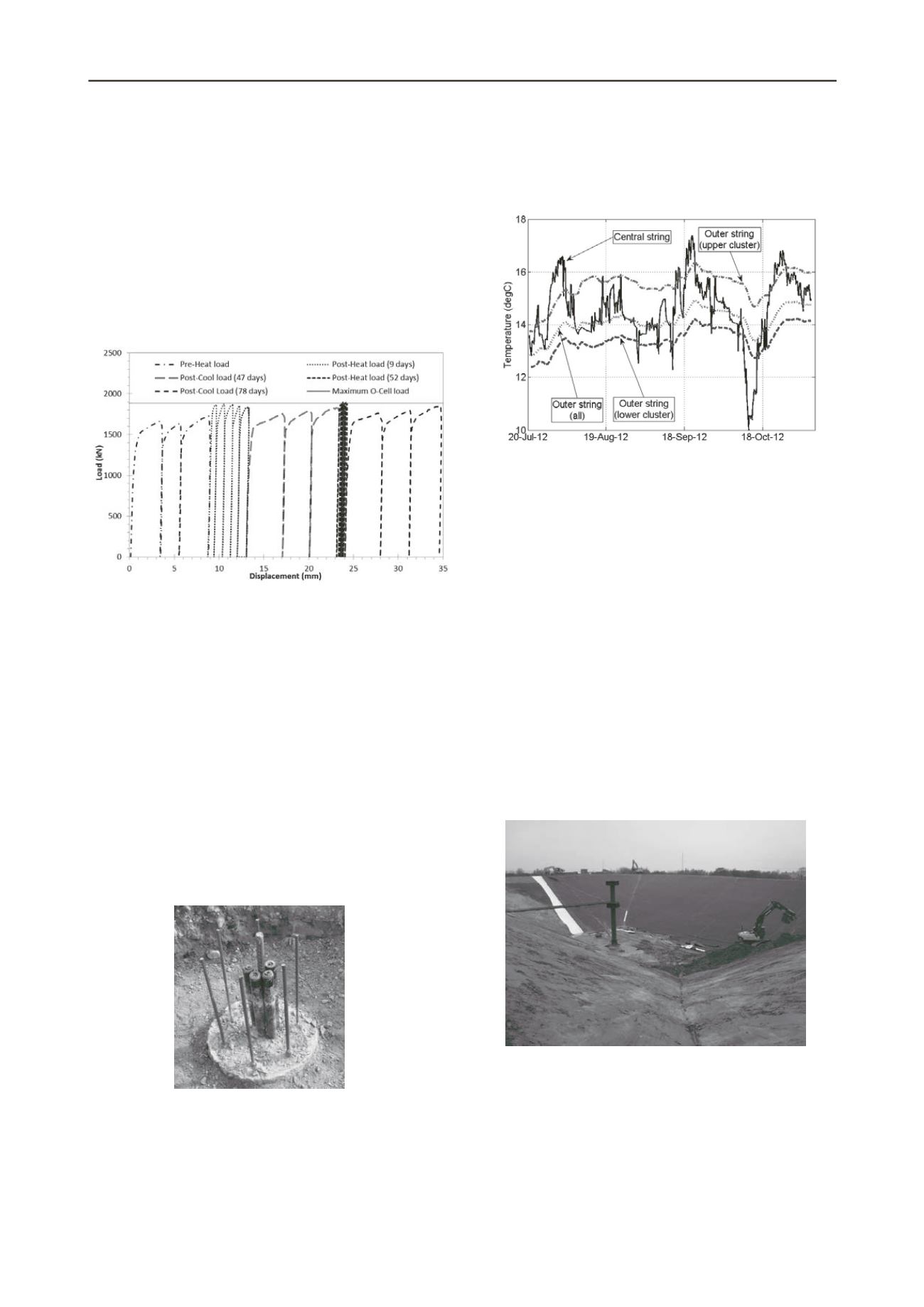
3341
Technical Committee 307 + 212 /
Comité technique 307 + 212
used for design of axially loaded pile, and is based on a model
that describes the mobilization of the soil shear strength along
the pile-soil interface. The effect of temperature is introduced in
the calculation by imposing axial dilation or contraction of the
pile corresponding to its thermal dilation or contraction. The
analysis produced axial stresses along the pile and pile head
displacement under different temperature changes and different
pile head conditions. The second method takes into account the
effect of thermal cycles. A more complex constitutive model
Modjoin was used to simulate the soil-pile interface.
Simulations using this model showed that thermal cycles can
induce cumulative settlement at the pile head or generate axial
stresses along the pile.
Figure 17. Load versus pile upper-section average shaft displacement –
initial, after heating and after cooling (Figure 3 of Wang et al.).
Loveridge and Powrie focussed on the thermal aspects of
energy piles. As part of their study, the authors monitored an
instrumented pile heat-exchanger system in East London and
presented the initial data from the first few months of operation
of the energy system. Each pile in the system was installed with
a pair of plastic U-pipes, which were inserted into the center of
the pile (Figure 18) after the pile cage had been plunged into the
concrete. Loveridge and Powrie described the ground conditions
and the details of the instrumentation, and analyzed the initially
collected data (Figure 19). The data demonstrated the transient
nature of the heat transfer within the pile which is not taken into
account in most existing design methods. The pile concrete was
found to store thermal energy in the short term. The authors
concluded that neglecting the short term storage capacity of
concrete makes the design over conservative, underestimates the
thermal capacity of the pile, and leads to an over estimation of
the risk of ground freezing for large diameter piles.
Figure 18. Typical pile heat exchanger at the East London site (Figure 1
of Loveridge and Powrie).
Ponomarov and Zakhrov reported another energy pile
foundation application in Russia. Field studies were carried out
in a pilot site to determine the temperature distribution in the
ground mass, the change of groundwater level, and the physical-
mechanical and thermal-physical characteristics of the ground
mass. The temperature distribution in the ground and its
seasonal variations were obtained from the field monitoring
data. In addition, numerical simulations were performed for
quantitative evaluation of the thermal energy extracted from
different energy foundations under the given climatic and
hydro-geologic conditions.
Figure 19. Mean thermistor string temperatures (Figure 6 of Loveridge
and Powrie).
The study by Andersen et al. is not related to geothermal
energy extraction but to thermal energy storage in an excavated
pit in Marstal, Denmark. Thermal energy is usually stored by
heating up a material using the available external source of
energy (e.g., solar energy), and then this heat is recycled to the
consumers using a heat pump. Several thermal energy storage
systems using tanks, aquifer, pits, and boreholes are currently
used or being considered in Denmark. Andersen et al. described
the Marstal town pit-based thermal storage system (PTES),
which aims at storing 100% renewable energies in the near
future. The authors were involved with the various geotechnical
difficulties that occurred during the construction of the PTES
shown in Figure 20, which included the excavation stability, the
groundwater and soil handling during the construction phase,
and the long term consequences of thermal influence on
deformations during the operational phase. According to the
authors, PTES is applicable to other sites, and the utilization of
renewable energy using PTES will enhance the renewable
energy resources of other cities in Denmark.
Figure 20. PTES at Marstal, Denmark during completion of excavation
and laying out of membrane (Figure 3 of Anderson et al.).
3 SUMMARY
Thermal geomechanincs is an important sub-discipline of
geotechnical engineering that has applications in geothermal-
energy extraction and thermal-energy storage, soil-structure
response due to climate change, storage of nuclear wastes, and
several other areas that contribute to the sustainable
development of civil infrastructure. This general report


